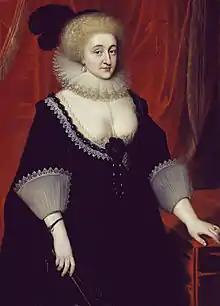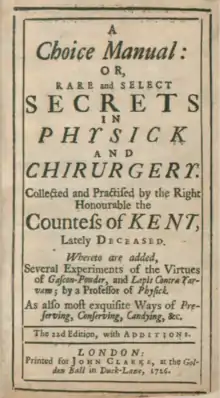Elizabeth Grey, Countess of Kent
Elizabeth Grey, Countess of Kent (née Lady Elizabeth Talbot) (1582 – 7 December 1651) was a medical recipe collector, and the wife of Henry Grey, 8th Earl of Kent.
Elizabeth Grey | |
|---|---|
| Countess of Kent | |
 Portrait of Elizabeth Grey by Paul Van Somer, ca. 1619 | |
| Born | 1582 |
| Died | December 7, 1651 Friary House, Whitefriars, London |
| Spouse(s) | Henry Grey, 8th Earl of Kent |
| Father | Gilbert Talbot, 7th Earl of Shrewsbury |
| Mother | Mary Cavendish |
Biography
She was a daughter of Gilbert Talbot, 7th Earl of Shrewsbury and Mary Cavendish.[1]
She married Grey on 16 November 1601, at St Martin-in-the-Fields. They lived at Wrest Park, Bedfordshire, where she managed the large household.[2] They had no children, and the Earl died in 1639.[3] Afterwards she may have married the writer, John Selden, who had worked for the Earl and to whom she left most of her property.[4]
She was a favourite attendant of Queen Anne of Denmark,[5] and in 1610 danced in the court masque Tethys' Festival as the "Nymph of Medway".[6] It was said she replaced Jean Drummond as the queen's personal servant in October 1617.[7] Her portrait by Paul van Somer includes a jewelled tablet or locket with the Queen's monogram.[8]

After her death, her collection of medical recipes was published, originally as A Choice Manual, or Rare Secrets in Physick and Chirurgery Collected and Practised by the Right Honourable the Countess of Kent, late deceased. Later editions of the book added the subtitle Whereto are added several experiments of the vertue of Gascon powder, and lapis contra yarvam by a professor of physick. As also most exquisite ways of preserving, conserving, candying &c..[9] The book was popular, going through twenty-two editions.[10] Some of the recipes reflect the influence of English Paracelsianism.[11] Medical recipes were an interest she shared with her younger sister, Alethea Howard, Countess of Arundel.
A book published in 1653 by W. J. Gent, titled A True Gentlewoman's Delight, is considered to be her personal recipe collection, although there is speculation that the cookbook was written by the countess's chef Robert May, or by the publisher himself.[12]
References
- Kingsford, Charles Lethbridge. "Grey Elizabeth". Dictionary of National Biography, 1885-1900. 23.
- Hartley, Cathy (1 January 2003). A Historical Dictionary of British Women. Psychology Press. p. 194. ISBN 9781857432282.
- Burke's Peerage and Baronetage, 76th ed. p. 823, (London and New York, 1914).
- Kingsford, Charles Lethbridge. "Grey Elizabeth". Dictionary of National Biography, 1885-1900. 23.
- Tate. "'Lady Elizabeth Grey, Countess of Kent', Paul Van Somer c.1619 | Tate". Tate. Retrieved 28 April 2017.
- John Nichols, The Progresses, Processions, and Magnificent Festivities, of King James the First, vol. 2 (London, 1828), p. 348.
- HMC 75 Downshire, vol. 6 (London, 1995), p. 300.
- Jemma Field, Anna of Denmark: The Material and Visual Culture of the Stuart Courts (Manchester, 2020), p. 165.
- Furdell, Elizabeth Lane (1 January 2002). Publishing and Medicine in Early Modern England. University Rochester Press. pp. 223n96. ISBN 9781580461191.
- "The Countess of Kent's Powder: A Seventeenth-Century "Cure-all"". The Recipes Project. Retrieved 28 April 2017.
- Spiller, Elizabeth (1 January 2008). Seventeenth-century English Recipe Books: Cooking, Physic and Chirurgery in the Works of Elizabeth Talbot Grey and Aletheia Talbot Howard. Ashgate Publishing, Ltd. pp. xxxiii. ISBN 9780754651963.
- Willan, Anne; Mark Cherniavsky, Mark (2012). The Cookbook Library: Four Centuries of the Cooks, Writers, and Recipes That Made the Modern Cookbook. University of California Press. p. 133. ISBN 9780520244009.
Attribution
 This article incorporates text from a publication now in the public domain: . Dictionary of National Biography. London: Smith, Elder & Co. 1885–1900.
This article incorporates text from a publication now in the public domain: . Dictionary of National Biography. London: Smith, Elder & Co. 1885–1900.